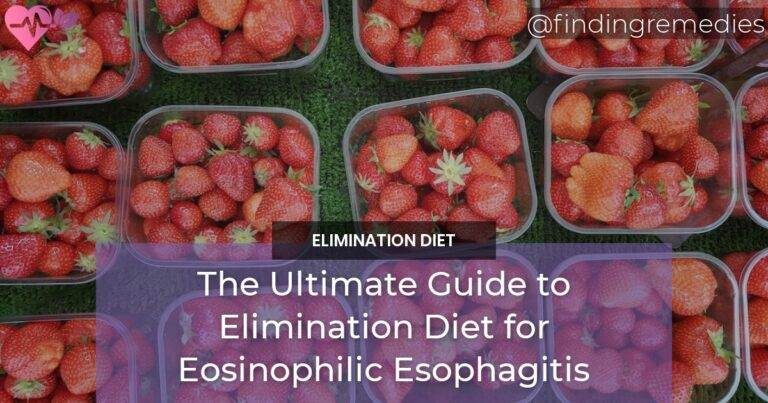Welcome to the ultimate guide to the elimination diet for Eosinophilic Esophagitis (EoE). EoE is an increasingly common and often debilitating digestive disorder that can cause difficulty swallowing, chest pain, heartburn, and other symptoms. As a result, many people are seeking to learn more about how to reduce their symptoms and manage the condition.
This guide will provide an overview of EoE and discuss the elimination diet, an important tool for treating it. We’ll cover what an elimination diet is, how it works, and which foods should be avoided. We’ll also discuss tips for following the diet, potential risks, and other lifestyle changes that may help manage EoE. So let’s get started on your journey to better health and a better quality of life.
Table of Contents
Overview
What is EoE?
Eosinophilic esophagitis (EoE) is a chronic immune-mediated disorder characterized by inflammation of the esophagus, which causes difficulty swallowing and food impaction. EoE is a rare condition that affects both children and adults. It is often misdiagnosed as gastroesophageal reflux disease (GERD) because of similar symptoms. However, EoE is not caused by reflux or heartburn.
Symptoms of EoE
The symptoms of EoE include difficulty swallowing, food getting stuck in the throat, chest pain, heartburn, nausea, vomiting, and weight loss. In children, EoE can cause poor growth and malnutrition.
Causes of EoE
The exact cause of EoE is unknown. However, it is believed to be caused by a combination of genetic and environmental factors. EoE is associated with food allergies, environmental allergies, and autoimmune disorders.
The Connection Between Diet and EoE
EoE is strongly associated with food allergies and sensitivities. Studies have shown that eliminating certain foods from the diet can help reduce inflammation in the esophagus and improve symptoms of EoE.
Elimination Diet for Eosinophilic Esophagitis
What is an Elimination Diet?
An elimination diet is a dietary intervention that involves removing certain foods from the diet for a period of time and then reintroducing them to identify food triggers.
Why an Elimination Diet is Recommended for EoE
Elimination diets are recommended for EoE to identify food triggers and reduce inflammation in the esophagus. The most common triggers of EoE are dairy, wheat, soy, eggs, and nuts.
Foods to Avoid During an EoE Elimination Diet
During an EoE elimination diet, it is important to avoid the most common food triggers, including dairy, wheat, soy, eggs, and nuts. Other potential triggers include fish, shellfish, corn, and legumes.
ALSO READ
How to Do an Elimination Diet for EoE
To do an elimination diet for EoE, it is recommended to work with a registered dietitian who specializes in food allergies and sensitivities. The dietitian will help create a customized elimination diet plan based on your individual needs.
Introduction of Foods Back into Your Diet
After the elimination phase, foods are gradually reintroduced to identify potential triggers. This process should be done under the supervision of a registered dietitian.
Meal Planning for an EoE Elimination Diet
Importance of Meal Planning for EoE
Meal planning is essential for an EoE elimination diet to ensure that you are getting all of the necessary nutrients and avoiding potential triggers.
Foods to Include in an EoE Elimination Diet
Foods that are safe to eat during an EoE elimination diet include fresh fruits and vegetables, lean proteins, rice, quinoa, gluten-free oats, and non-dairy milk.
Sample Meal Plan for EoE Elimination Diet
Breakfast: Gluten-free oats with non-dairy milk and fresh berries
Snack: Apple slices with almond butter
Lunch: Grilled chicken breast with roasted sweet potatoes and green beans
Snack: Carrot sticks with hummus
Dinner: Grilled salmon with quinoa and steamed broccoli
ALSO READ
Keeping a Food Diary with EoE
Importance of Keeping a Food Diary for EoE
Keeping a food diary is important for EoE to track symptoms and identify potential food triggers.
How to Keep a Food Diary for EoE
To keep a food diary for EoE, write down everything you eat and drink, including the time and any symptoms that occur after.
Tips for Recording Foods and Symptoms
Record foods and symptoms in a notebook or on a smartphone app. Be specific about the portion size and preparation method of foods. Also, record any medications or supplements you are taking.
Food Challenges for EoE
Importance of Food Challenges for EoE
Food challenges are important for EoE to determine if a food trigger has been identified.
How to Do a Food Challenge for EoE
To do a food challenge for EoE, reintroduce a single food at a time in increasing amounts and monitor for symptoms.
What to Expect During a Food Challenge
During a food challenge, it is normal to experience some mild symptoms. However, if symptoms persist or worsen, the food may be a trigger and should be avoided in the future.
In conclusion, an elimination diet is an effective way to identify food triggers and reduce inflammation in the esophagus for people with EoE. It is recommended to work with a registered dietitian who specializes in food allergies and sensitivities to create a customized elimination diet plan. Keeping a food diary is also important for EoE to track symptoms and identify potential food triggers. With the right diet and lifestyle modifications, people with EoE can live a symptom-free life.
RELATED ARTICLES:

